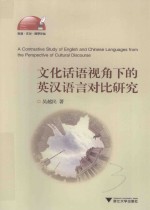

文化话语视角下的英汉语言对比研究 英文PDF格式文档图书下载
- 购买点数:11 点
- 作 者:吴越民著
- 出 版 社:杭州:浙江大学出版社
- 出版年份:2015
- ISBN:9787308145039
- 标注页数:297 页
- PDF页数:310 页
Chapter 1 Language and Culture 1
1.1 Language 1
1.1.1 The Definition of Language 1
1.1.2 The Components of Language 2
1.1.3 The Characteristics of Language 5
1.2 Culture 12
1.2.1 The Definition of Culture 12
1.2.2 The Components of Culture 14
1.2.3 The Characteristics of Culture 14
1.2.4 The Elements of Cultural Patterns 18
1.2.5 High-context and Low-context Cultural Patterns 21
1.2.6 Culture and Related Terms 25
1.3 Relationship between Language and Culture 30
1.3.1 Language Is Part of Culture 30
1.3.2 Language Is the Carrier and Container of Culture 31
1.3.3 Language Is Strongly Influenced and Shaped by Culture 31
1.3.4 Language Exerts Its Influence on Culture 32
1.3.5 Language and Culture Influence and Shape Each Other 33
Chapter 2 Discourse and Semiotics 34
2.1 Discourse 34
2.1.1 The Definition of Discourse 34
2.1.2 Language and Discourse 35
2.1.3 The Definition of Discourse Analysis 37
2.1.4 Cultural Discourse 39
2.2 Semiotics 41
2.2.1 The Definition of Semiotics 41
2.2.2 Sign Systems 42
2.2.3 Cultural Semiotics 45
2.2.4 Codes 46
2.2.5 Symbols 47
2.2.6 Semiotic Analysis 51
Chapter 3 Semantics and Contexts 54
3.1 Semantics 54
3.1.1 Word Meanings 55
3.1.2 Conceptual Meanings and Associative Meanings 60
3.2 Contexts 62
3.2.1 Social Contexts 64
3.2.2 Cultural Contexts 65
3.3 Semantic Differences 66
3.3.1 Words with Basically the Same Conceptual and Associative Meanings 68
3.3.2 Different Words Conveying the Same Cultural Meanings 68
3.3.3 Same Words Conveying Different Associative Meanings 69
3.3.4 Words with Surface Similarity but Actual Semantic Differences 73
3.3.5 Lexical Gaps in Different Cultures 74
Chapter 4 Animals and Plants 77
4.1 Animals 77
4.1.1 Dog(狗) 79
4.1.2 Fish(鱼) 80
4.1.3 Sheep(羊) 82
4.1.4 Horse(马) 83
4.1.5 Lion(狮) 84
4.1.6 Tiger(虎) 85
4.1.7 Cattle(牛) 86
4.1.8 Rabbit(兔) 88
4.1.9 Tortoise(龟) 89
4.1.10 Owl(猫头鹰) 90
4.1.11 Bat(蝙蝠) 92
4.1.12 Crane(仙鹤) 92
4.1.13 Magpie(喜鹊) 93
4.2 Plants 94
4.2.1 Rose(玫瑰) 94
4.2.2 Plum(梅),Orchid(兰),Bamboo(竹)and Chrysanthemum(菊) 95
4.2.3 Pine(松) 97
4.2.4 Bodhi Tree(菩提树) 98
4.2.5 Lotus(莲花,荷花) 98
4.2.6 Apple(苹果) 99
4.2.7 Peach(桃) 101
4.2.8 Willow(柳) 102
Chapter 5 Colors and Numbers 104
5.1 Colors 104
5.1.1 Red(红) 106
5.1.2 White(白) 111
5.1.3 Black(黑) 113
5.1.4 Green(绿) 115
5.1.5 Yellow(黄) 117
5.1.6 Blue(蓝) 119
5.1.7 Grey(灰) 120
5.1.8 Pink(粉红) 120
5.1.9 Purple(紫) 121
5.2 Numbers 121
5.2.1 One(一) 122
5.2.2 Two(二) 123
5.2.3 Three(三) 123
5.2.4 Four(四) 130
5.2.5 Five (五) 134
5.2.6 Six (六) 137
5.2.7 Seven(七) 138
5.2.8 Eight(八) 139
5.2.9 Nine(九) 140
5.2.10 Ten(十) 141
5.2.11 Thirteen(十三) 142
Chapter 6 Grammar and Text 144
6.1 Grammar 144
6.1.1 Morphemes 145
6.1.2 Syntactical Rules 147
6.1.3 Explicit Grammar and Implicit Grammar 149
6.1.4 Subjects and Objects 150
6.1.5 Paratactic and Hypotactic Relations 151
6.1.6 Branching and Linear Sentence Patterns 152
6.1.7 Word Order 153
6.1.8 Cultural Differences behind Grammar 154
6.2 Text 156
6.2.1 The Definition of Text 157
6.2.2 Cohesion and Coherence 157
6.2.3 Textual Connectives 158
6.2.4 Textual Structures 162
6.2.5 Cultural Differences behind Text 166
Chapter 7 Simile and Metaphor 172
7.1 Simile 172
7.1.1 The Definition of Simile 173
7.1.2 Cultural-alike Associations in English and Chinese Similes 174
7.1.3 Cultural-distinct Associations in English and Chinese Similes 175
7.2 Metaphor 177
7.2.1 The Definition of Metaphor 177
7.2.2 Cultural Metaphors 178
7.2.3 Cultural-alike Associations in English and Chinese Metaphors 181
7.2.4 Cultural-distinct Associations in English and Chinese Metaphors 182
7.3 Translation 184
7.3.1 Literal Translation 185
7.3.2 Cultural Translation 188
Chapter 8 Idioms and Proverbs 191
8.1 Idioms 191
8.1.1 Cultural Similarities between Chinese and English Idioms 193
8.1.2 Cultural Disparities between Chinese and English Idioms 193
8.2 Proverbs 197
8.2.1 Some Equivalent Proverbs in English and Chinese 198
8.2.2 Proverbs Related to Different Religions 198
8.2.3 Proverbs Derived from Literary Works 201
8.2.4 Proverbs Originating from Geographical Environments 202
8.2.5 Proverbs Reflecting Values and Viewpoints 204
Chapter 9 Allusions and Euphemisms 214
9.1 Allusions 214
9.1.1 Allusions from Literature 215
9.1.2 Allusions from History 220
9.1.3 Allusions from Mythology and Legends 221
9.1.4 Allusions from Sports 225
9.1.5 The Contrastive Analysis of English and Chinese Allusions 227
9.2 Euphemisms 228
9.2.1 To Avoid Taboos 229
9.2.2 To Show Politeness 233
9.2.3 To Conceal Truth 236
Chapter 10 Taboos and Sexism 239
10.1 Taboos 239
10.1.1 The Definition of Taboo 240
10.1.2 Verbal Taboos in Different Cultures 240
10.1.3 Nonverbal Taboos in Different Cultures 245
10.2 Sexism 249
10.2.1 Sexist Language in English 250
10.2.2 Sexist Language in Chinese 257
Chapter 11 Advertising and Culture 261
11.1 The Definition of Advertising 261
11.2 The Development of Advertising 262
11.2.1 The Evolution of Western Advertising 262
11.2.2 Chinese Economic Reform and Advertising 264
11.3 The Techniques of Advertising 266
11.4 The Linguistic Features of Advertising 267
11.4.1 Phonetic Features of Advertisements 268
11.4.2 Lexical Features of Advertisements 269
11.4.3 Rhetorical Devices of Advertisements 271
11.5 Brand Names 274
11.5.1 Brand Names and Cultural Connotations 275
11.5.2 Coinages in English and Chinese Brand Names 276
11.5.3 Exotic Flavor in English and Chinese Brand Names 276
11.5.4 Cultural Connotations in English and Chinese Brand Names 277
11.6 Logos 278
11.7 Cultural Differences in English and Chinese Advertising 280
11.7.1 Advertising Legislations in Different Cultures 280
11.7.2 Family Image in Chinese Advertisements 281
11.7.3 Authoritative Worship and Factual Proofs 282
11.7.4 Collective Orientation and Individualistic Centeredness 283
Glossary(Index of Important Terms) 286
Bibliography 294
- 《文化话语视角下的英汉语言对比研究 英文》吴越民著 2015
- 《跨文化媒体话语中的视角化研究》吴琼著 2017
- 《汉英会话语篇对比研究》王望妮编著 2012
- 《语言类型学视角下的韩汉语语序对比研究》 2222
- 《对比语言学视角下的外语教学研究》杨立刚著 2013
- 《汉语话语标记多视角研究》曹秀玲著 2016
- 《话语分析视角下的现代汉语反问句研究》于天昱著 2018
- 《语用视点 话语研究的新视角》唐淑华著 2014
- 《国家、区域与企业传播研究 话语分析视角》刘立华主编 2016
- 《篇章分析 汉法话语范围导入词对比研究》王秀丽著 2008
- 《文化语境中的西方新闻话语 英文》吴越民著 2013
- 《文化话语视角下的英汉语言对比研究 英文》吴越民著 2015
- 《女性形象塑造的跨文化研究 基于中美部分主流报纸的对比分析》吴越民著 2011
- 《智慧城市》王辉,吴越,章建强等编著 2010
- 《火焰集》吴越著 1964
- 《智慧城市 第2版》王辉,吴越,章建强等编著 2010
- 《侍从室最高机密》吴越,吴佩珏,1932- 1996
- 《电脑英语翻译软件》吴越编著 1998
- 《电脑音乐入门》吴越编著 1998
- 《当时已惘然》吴越著 2007
